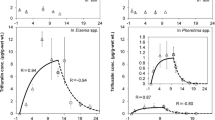Abstract
A simple and dynamic pharmacokinetic model was developed to predict bioconcentration of organic contaminants in earthworms. The model was parameterized experimentally by placing Lumbricus terrestris in soil contaminated with 200 µg/cm2 of malathion. The toxicokinetics of malathion uptake, depuration, and degradation in soil is measured. After parameterization, the model was able to accurately predict the bioconcentration factor of malathion at steady state. Sensitivity analyses were performed and the rate of absorption was determined to be the most sensitive parameter. Varying the rate of malathion elimination from earthworm tissues, malathion degradation, and the amount of malathion applied to the soil by 25-fold did not result in the bioconcentration of malathion. An increase in the rate of malathion absorption into earthworm tissues by 25-fold did result in bioconcentration. Previously published pharmacokinetic studies on xenobiotics with log K ow values ranging up to 8.05 were used to test the predictive capacity of the model. The model was able to predict from 83% to 105% of the experimentally derived bioconcentration factors.





Similar content being viewed by others
References
Albro, P., Schroeder, J., et al. (1992). Lipids of the earthworm Lumbricus terrestris. Lipids, 27(2), 136–143.
Belfroid, A., Van Den Berg, M., et al. (1995). Uptake, bioavailability, and elimination of hydrophobic compounds in earthworms (Eisenia andrei) in field-contaminated soil. Environmental Toxicity and Chemistry, 14(4), 605–612.
Beyer, W., & Cromartie, E. (1987). A survey of Pb, Cu, Zn, Cd, Cr, As, and Se in earthworms and soil from diverse sites. Environmental Monitoring and Assessment, 8(1), 27–36.
Blair, J., Parmelee, R., et al. (1995). Influences of earthworms on biogeochemistry. Earthworm ecology and biogeography in North America. P. Hendrix pp. 128–150. Boca Raton: CRC.
Bouchard, M., Gosselin, N., et al. (2003). A toxicokinetic model of malathion and its metabolites as a tool to assess human exposure and risk through measurements or urinary biomarkers. Toxicological Sciences, 73, 182–194.
Boutisiouki, P., Thompson, J. P., et al. (2001). Effects of local blood flow on the percutaneous absorption of the organophosphorous compound malathion: a microdialysis study in man. Archives of Toxicology, 75, 321–328.
Brown, H., & Hattis, D. (1989). The role of skin absorption as a route of exposure to volatile organic compounds in household tap water: a simulated kinetic approach. Journal of the American College of Toxicology, 8(5), 839–851.
Brown, P., Long, S., et al. (2004). Toxicology and biochemical responses of the earthworm Lumbricus rubellus to pyrene, a non-carcinogenic polycyclic aromatic hydrocarbon. Chemosphere, 57, 1675–1681.
Carver, M., Williams, P., et al. (1989). The isolated perfused porcine skin flap. III. Percutaneous absorption pharmacokinetics of organophosphates, steroids, benzoic acid, and caffeine. Toxicological and Applied Pharmacology, 97(2), 324–337.
Connell, D., & Markwell, R. (1990). Bioaccumulation in the soil to earthworm system. Chemosphere, 20(1–2), 91–100.
Edwards, C., & Bohlen, P. (1992). The effects of toxic chemicals on earthworms. Reviews of Environmental Contamination and Toxicology, 125, 23–95.
Environmental Protection Agency (2000). Malathion: environmental fate and effects. Washington DC: EPA.
Eto, M. (1974). Organophosphorus Pesticides: Organic and Biological Chemistry. Cleveland: CRC.
Folch, J., Lees, M., et al. (1957). A simple method for the isolation and purification of total lipids from animal tissues. Journal of Biology and Chemistry, 226, 497–509.
Haines, P., & Uren, N. (1990). Effects of conservation tillage farming on soil microbial biomass, organic matter, and earthworm populations, in north–eastern Victoria. Australian Journal of Experimental Agriculture, 30(3), 365–371.
Hendrix, P. (1995). Earthworm ecology and biogeography in North America. Boca Raton: CRC.
Jager, T. (1998). Mechanistic approach for estimating bioconcentration of organic chemicals in earthworms (Oligochaeta). Environmental Toxicology and Chemistry, 17(10), 2080–2090.
Jamieson, B. G. M. (1981). The integumentary system. The ultrastructure of Oligochaeta pp. 10–42. New York: Academic.
Johnson, M., Franke, L., et al. (1999). Bioaccumulation of 2,4,6-trinitrotoluene and polychlorinated biphenyls through two routes of exposure in a terrestrial amphibian: is the dermal route significant? Environmental Toxicology and Chemistry, 18(5), 873–876.
Lanno, R., Wells, J., et al. (2004). The bioavailability of chemicals in soils for earthworms. Ecotoxicology and Environmental Safety, 57, 39–47.
Panda, S., & Sahu, S. (2002). Acute toxicity assessment of three pesticides to the earthworm Drawida willsi. Journal of Ecotoxicology and Environmental Monitoring, 12(3), 215–223.
Roberts, B., & Dorough, W. (1984). Relative toxicities of chemicals to the earthworm Eisenia foetida. Environmental Toxicology and Chemistry, 3, 67–78.
Rozman, K., & Klaassen, C. (2001). Absorption, distribution, and excretion of toxicants. In C. Klaassen (Ed.) Casarett and Doull's toxicology: the basic science of poisons (pp. 107–132). New York: McGraw-Hill.
Sample, B., Suter, G., et al. (1999). Literature-derived bioaccumulation models for earthworms: development and validation. Environmental Toxicity and Chemistry, 18(9), 2110–2120.
Sartorelli, P., Aprea, C., et al. (1998). Prediction of percutaneous absorption from physiochemical data: a model based upon data of in vitro experiments. The Annals of Occupational Hygiene, 42(4), 267–276.
Schaefer, M. (2004). Assessing 2,4,6-trinitrotoluene (TNT)-contaminated soil using three different earthworm test methods. Ecotoxicology and Environmental Safety, 57, 74–80.
Senapati, B. K., Biswal, J., et al. (1991). Impact of malathion on Drawidi willsi, a dominant earthworm in Indian rice fields. Pedobiologia, 35, 117–128.
Shatkin, J. A., & Brown, H. (1991). Pharmacokinetics of the dermal route of exposure to volatile organic chemicals in water: a computer simulation model. Environmental Reseach, 56, 90–108.
Shipitalo, M., Edwards, W., et al. (1994). Comparison of water movement and quality in earthworm burrows and pan lysimeters. Journal of Environmental Quality, 23(6), 1345–1351.
Stephenson, G., Wren, C., et al. (1997). Exposure of the earthworm, Lumbricus terrestris, to diazinon, and the relative risk to passerine birds. Soil Biology and Biochemistry, 29(3/4), 717–720.
van der Merwe, D., Brooks, J., et al. (2006). A physiologically based pharmacokinetic model of organophosphate dermal absorption. Toxicological Sciences, 89(1), 188–204.
Van Gestel, C., & Weeks, J. (2004). Recommendations of the 3rd International Workshop on earthworm ecotoxicology, Aarhus, Denmark, August 2001. Ecotoxicology and Environmental Safety, 57, 100–105.
Venturino, A., Gauna, L., et al. (2001). Toxicokinetics of malathion in larval stages of the toad Bufo arenarum (Hensel): effect of exogenous spermidine. Pesticide Biochemistry and Physiology, 70, 142–150.
Willens, S. (2005). Effects of percutaneous malathion absorption in anurans. Comparative biomedical sciences p. 108. Raleigh: North Carolina State University.
Woodruff, T., Bois, F., et al. (1992). Structure and parameterization of pharmacokinetic models: their impact on model predictions. Risk Analysis, 12(2), 189–201.
Acknowledgements
The US Environmental Protection Agency (EPA) through its Office of Research and Development partially funded and collaborated in the research described here under assistance agreement # R-83055101 to North Carolina State University. The views expressed in this article are those of the authors and do not necessarily reflect the view or policies of the EPA.
Author information
Authors and Affiliations
Corresponding author
Rights and permissions
About this article
Cite this article
Henson-Ramsey, H., Levine, J., Kennedy-Stoskopf, S. et al. Development of a Dynamic Pharmacokinetic Model to Estimate Bioconcentration of Xenobiotics in Earthworms. Environ Model Assess 14, 411–418 (2009). https://doi.org/10.1007/s10666-007-9132-4
Received:
Accepted:
Published:
Issue Date:
DOI: https://doi.org/10.1007/s10666-007-9132-4




